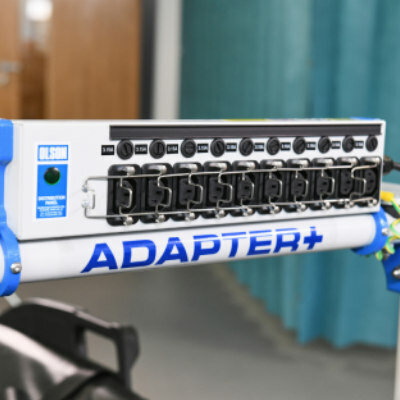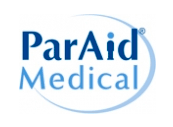Abdominal CT Scans that Assess Body Composition of Hospitalized COVID-19 Patients Can Predict Adverse Outcomes
|
By HospiMedica International staff writers Posted on 19 Jul 2021 |

Image: Body composition assessment in patients with COVID-19 (Photo courtesy of Nature)
Obesity is a strong risk factor for adverse outcomes in patients hospitalized with COVID-19, although the distribution of fat and the amount of muscle mass are more accurate risk factors than body mass index (BMI), according to a new study.
The objective of the study by researchers at Harvard Medical School (Boston, MA, USA) was to assess body composition measures obtained on opportunistic abdominal computed tomography (CT) as predictors of outcome in patients hospitalized with COVID-19. The researchers hypothesized that elevated visceral and intermuscular adipose tissue would be associated with adverse outcome.
Several studies suggest that obesity is a strong risk factor for adverse outcome in patients hospitalized with COVID-19. BMI is commonly used to assess obesity, but cardiometabolic risk and mortality vary considerably among patients with the same BMI, which is partially attributable to differences in body composition. The distribution of fat and the amount of muscle mass are more accurate risk factors than BMI for cardiometabolic risk. Patients admitted to the hospital for COVID-19 often undergo CT of the chest or abdomen for clinical care and these CTs could be used to assess body composition without additional costs or radiation exposure.
In the latest study, the researchers looked at 124 patients (median age: 68 years, IQR: 56, 77; 59 weeks, 65 months) who were admitted with COVID-19 to a single hospital and who had undergone abdominal CT for clinical purposes. Visceral adipose tissue (VAT), subcutaneous adipose tissue (SAT), intermuscular adipose tissue (IMAT), and paraspinal and abdominal muscle cross-sectional areas (CSA) were assessed. Clinical information including prognostic factors, time of admission to the intensive care unit (ICU) and time of death within 28 days were obtained. Multivariate time-to-event competing risk models were fitted to estimate the hazard ratio (HR) for a composite outcome of ICU admission/mortality associated with a one standard deviation increase in each body compositional measure. Each model was adjusted for age, sex, race, BMI, and cardiometabolic comorbidities.
The study found that there were 50 patients who were admitted to the ICU or deceased over a median time of 1 day [IQR 1, 6] from hospital admission. Higher VAT/SAT ratio (HR of 1.30; 95% CI 1.04-1.62, p = 0.022) and higher IMAT CSA (HR of 1.44; 95% CI 1.10-1.89, p = 0.008) were associated with a reduced time to ICU admission or death in adjusted models. The researchers concluded that VAT/SAT and IMAT are predictors of adverse outcome in patients hospitalized with COVID-19, independent of other established prognostic factors. This suggests that body composition measures may serve as novel biomarkers of outcome in patients with COVID-19.
Related Links:
Harvard Medical School
The objective of the study by researchers at Harvard Medical School (Boston, MA, USA) was to assess body composition measures obtained on opportunistic abdominal computed tomography (CT) as predictors of outcome in patients hospitalized with COVID-19. The researchers hypothesized that elevated visceral and intermuscular adipose tissue would be associated with adverse outcome.
Several studies suggest that obesity is a strong risk factor for adverse outcome in patients hospitalized with COVID-19. BMI is commonly used to assess obesity, but cardiometabolic risk and mortality vary considerably among patients with the same BMI, which is partially attributable to differences in body composition. The distribution of fat and the amount of muscle mass are more accurate risk factors than BMI for cardiometabolic risk. Patients admitted to the hospital for COVID-19 often undergo CT of the chest or abdomen for clinical care and these CTs could be used to assess body composition without additional costs or radiation exposure.
In the latest study, the researchers looked at 124 patients (median age: 68 years, IQR: 56, 77; 59 weeks, 65 months) who were admitted with COVID-19 to a single hospital and who had undergone abdominal CT for clinical purposes. Visceral adipose tissue (VAT), subcutaneous adipose tissue (SAT), intermuscular adipose tissue (IMAT), and paraspinal and abdominal muscle cross-sectional areas (CSA) were assessed. Clinical information including prognostic factors, time of admission to the intensive care unit (ICU) and time of death within 28 days were obtained. Multivariate time-to-event competing risk models were fitted to estimate the hazard ratio (HR) for a composite outcome of ICU admission/mortality associated with a one standard deviation increase in each body compositional measure. Each model was adjusted for age, sex, race, BMI, and cardiometabolic comorbidities.
The study found that there were 50 patients who were admitted to the ICU or deceased over a median time of 1 day [IQR 1, 6] from hospital admission. Higher VAT/SAT ratio (HR of 1.30; 95% CI 1.04-1.62, p = 0.022) and higher IMAT CSA (HR of 1.44; 95% CI 1.10-1.89, p = 0.008) were associated with a reduced time to ICU admission or death in adjusted models. The researchers concluded that VAT/SAT and IMAT are predictors of adverse outcome in patients hospitalized with COVID-19, independent of other established prognostic factors. This suggests that body composition measures may serve as novel biomarkers of outcome in patients with COVID-19.
Related Links:
Harvard Medical School
Latest COVID-19 News
- Low-Cost System Detects SARS-CoV-2 Virus in Hospital Air Using High-Tech Bubbles
- World's First Inhalable COVID-19 Vaccine Approved in China
- COVID-19 Vaccine Patch Fights SARS-CoV-2 Variants Better than Needles
- Blood Viscosity Testing Can Predict Risk of Death in Hospitalized COVID-19 Patients
- ‘Covid Computer’ Uses AI to Detect COVID-19 from Chest CT Scans
- MRI Lung-Imaging Technique Shows Cause of Long-COVID Symptoms
- Chest CT Scans of COVID-19 Patients Could Help Distinguish Between SARS-CoV-2 Variants
- Specialized MRI Detects Lung Abnormalities in Non-Hospitalized Long COVID Patients
- AI Algorithm Identifies Hospitalized Patients at Highest Risk of Dying From COVID-19
- Sweat Sensor Detects Key Biomarkers That Provide Early Warning of COVID-19 and Flu
- Study Assesses Impact of COVID-19 on Ventilation/Perfusion Scintigraphy
- CT Imaging Study Finds Vaccination Reduces Risk of COVID-19 Associated Pulmonary Embolism
- Third Day in Hospital a ‘Tipping Point’ in Severity of COVID-19 Pneumonia
- Longer Interval Between COVID-19 Vaccines Generates Up to Nine Times as Many Antibodies
- AI Model for Monitoring COVID-19 Predicts Mortality Within First 30 Days of Admission
- AI Predicts COVID Prognosis at Near-Expert Level Based Off CT Scans
Channels
Artificial Intelligence
view channel
AI-Powered Algorithm to Revolutionize Detection of Atrial Fibrillation
Atrial fibrillation (AFib), a condition characterized by an irregular and often rapid heart rate, is linked to increased risks of stroke and heart failure. This is because the irregular heartbeat in AFib... Read more
AI Diagnostic Tool Accurately Detects Valvular Disorders Often Missed by Doctors
Doctors generally use stethoscopes to listen for the characteristic lub-dub sounds made by heart valves opening and closing. They also listen for less prominent sounds that indicate problems with these valves.... Read moreCritical Care
view channel
Deep-Learning Model Predicts Arrhythmia 30 Minutes before Onset
Atrial fibrillation, the most common type of cardiac arrhythmia worldwide, affected approximately 59 million people in 2019. Characterized by an irregular and often rapid heart rate, atrial fibrillation... Read more
Breakthrough Technology Combines Detection and Treatment of Nerve-Related Disorders in Single Procedure
The peripheral nervous system (PNS) serves as the communication network that links the brain and spinal cord to every other part of the body. It consists of two parts: the somatic nervous system, which... Read moreSurgical Techniques
view channel
Hydrogel-Based Miniaturized Electric Generators to Power Biomedical Devices
The development of engineered devices that can harvest and convert the mechanical motion of the human body into electricity is essential for powering bioelectronic devices. This mechanoelectrical energy... Read moreWearable Technology Monitors and Analyzes Surgeons' Posture during Long Surgical Procedures
The physical strain associated with the static postures maintained by neurosurgeons during long operations can lead to fatigue and musculoskeletal problems. An objective assessment of surgical ergonomics... Read more.jpg)
Custom 3D-Printed Orthopedic Implants Transform Joint Replacement Surgery
The evolving field of 3D printing is revolutionizing orthopedics, especially for individuals requiring joint replacement surgeries where traditional implants fail to provide a solution. Although most people... Read more
Cutting-Edge Imaging Platform Detects Residual Breast Cancer Missed During Lumpectomy Surgery
Breast cancer is becoming increasingly common, with statistics indicating that 1 in 8 women will develop the disease in their lifetime. Lumpectomy remains the predominant surgical intervention for treating... Read morePatient Care
view channel
Surgical Capacity Optimization Solution Helps Hospitals Boost OR Utilization
An innovative solution has the capability to transform surgical capacity utilization by targeting the root cause of surgical block time inefficiencies. Fujitsu Limited’s (Tokyo, Japan) Surgical Capacity... Read more
Game-Changing Innovation in Surgical Instrument Sterilization Significantly Improves OR Throughput
A groundbreaking innovation enables hospitals to significantly improve instrument processing time and throughput in operating rooms (ORs) and sterile processing departments. Turbett Surgical, Inc.... Read more
Next Gen ICU Bed to Help Address Complex Critical Care Needs
As the critical care environment becomes increasingly demanding and complex due to evolving hospital needs, there is a pressing requirement for innovations that can facilitate patient recovery.... Read moreGroundbreaking AI-Powered UV-C Disinfection Technology Redefines Infection Control Landscape
Healthcare-associated infection (HCAI) is a widespread complication in healthcare management, posing a significant health risk due to its potential to increase patient morbidity and mortality, prolong... Read moreHealth IT
view channel
Machine Learning Model Improves Mortality Risk Prediction for Cardiac Surgery Patients
Machine learning algorithms have been deployed to create predictive models in various medical fields, with some demonstrating improved outcomes compared to their standard-of-care counterparts.... Read more
Strategic Collaboration to Develop and Integrate Generative AI into Healthcare
Top industry experts have underscored the immediate requirement for healthcare systems and hospitals to respond to severe cost and margin pressures. Close to half of U.S. hospitals ended 2022 in the red... Read more
AI-Enabled Operating Rooms Solution Helps Hospitals Maximize Utilization and Unlock Capacity
For healthcare organizations, optimizing operating room (OR) utilization during prime time hours is a complex challenge. Surgeons and clinics face difficulties in finding available slots for booking cases,... Read more
AI Predicts Pancreatic Cancer Three Years before Diagnosis from Patients’ Medical Records
Screening for common cancers like breast, cervix, and prostate cancer relies on relatively simple and highly effective techniques, such as mammograms, Pap smears, and blood tests. These methods have revolutionized... Read morePoint of Care
view channel
Critical Bleeding Management System to Help Hospitals Further Standardize Viscoelastic Testing
Surgical procedures are often accompanied by significant blood loss and the subsequent high likelihood of the need for allogeneic blood transfusions. These transfusions, while critical, are linked to various... Read more
Point of Care HIV Test Enables Early Infection Diagnosis for Infants
Early diagnosis and initiation of treatment are crucial for the survival of infants infected with HIV (human immunodeficiency virus). Without treatment, approximately 50% of infants who acquire HIV during... Read more
Whole Blood Rapid Test Aids Assessment of Concussion at Patient's Bedside
In the United States annually, approximately five million individuals seek emergency department care for traumatic brain injuries (TBIs), yet over half of those suspecting a concussion may never get it checked.... Read more
New Generation Glucose Hospital Meter System Ensures Accurate, Interference-Free and Safe Use
A new generation glucose hospital meter system now comes with several features that make hospital glucose testing easier and more secure while continuing to offer accuracy, freedom from interference, and... Read moreBusiness
view channel
Johnson & Johnson Acquires Cardiovascular Medical Device Company Shockwave Medical
Johnson & Johnson (New Brunswick, N.J., USA) and Shockwave Medical (Santa Clara, CA, USA) have entered into a definitive agreement under which Johnson & Johnson will acquire all of Shockwave’s... Read more

















